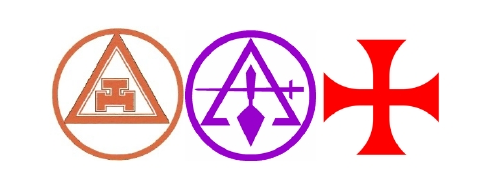
York Rite
(Charities: Royal Arch Research Assistance, Medical Research Foundation, Eye Foundation)
What is the Order?
The York Rite specifically is a collection of separate Masonic Bodies and associated Degrees that would otherwise operate independently. The three primary bodies in the York Rite are the Chapter of Royal Arch Masons, Council of Royal & Select Masters or Council of Cryptic Masons, and the Commandery of Knights Templar, each of which are governed independently but are all considered to be a part of the York Rite. The Rite’s name is derived from the city of York, where, according to a Masonic legend, the first meetings of Masons in England took place.
Purpose
Master Masons may proceed to supplement and amplify the Blue Lodge degrees, affording historical background on the work and meaning of Freemasonry. Most students of Freemasonry agree that the story of the Craft as presented in the three Blue Lodge degrees is incomplete and that the degrees offered in the York Rite of Freemasonry complete the story and answer many of the questions in the mind of the newly made Master Mason.
History
The oldest and perhaps the purest form of Ancient Craft Masonry takes its name from the City of York, in the north of England.
It was there in the year A. D. 926 that we find Masonry adopting its first recorded Constitution. It is recorded in many very ancient manuscripts that during the reign of the good King Athelstan he granted a patent to (his nephew) Prince Edwin, under authority of which an assembly of divers lords, dukes, barons, knights, squires, great burgesses of cities and many more, all Masons, convened in the City of York and adopted a Constitution of fifteen Articles for the future government of the Craft.
Based upon manuscripts from these proceedings, Dr. Anderson, in A. D. 1723, published the first edition of the Book of Constitutions, in which the history of the fraternity of Free Masons is, he says, “collected from their general records and their faithful traditions of many ages.” The history, as narrated herein, is repeated by Dr. Anderson and subsequently by Preston, author of the first Masonic Monitor.
The degrees recognized by the Grand Lodge of England, in 1717 A. D. were as follows:
“Pure ancient Masonry consists of three degrees, no more; viz: those of the Entered Apprentice, the Fellow Craft, and the Master Mason, including the Supreme Order of the Holy Royal Arch.”
It is therefore seen that the Royal Arch Degree was once a part of the Master’s Degree. It was the crowning feature and glorious completion of Ancient-Craft Masonry. The Grand Lodge of England to this day exercises jurisdiction over the “Holy Royal Arch.”
There was a schism in the Grand Lodge of England in 1738 A. D., at which time a rival Grand Lodge was organized by the schismatics. This situation continued for a period of seventy-five years. In 1813 the breach was healed by the reconciliation and union of the two Grand Lodges.
Council Officers
- Illustrious Master: Mike Martin
- Deputy Master: Thomas Carmen
- Principle Conductor of the Work: James Bell, III
- Treasurer: VIC Dave Haywood
- Recorder: VIC John Caraker
- Captain of the Guard: Michael Shirk
- Conductor of the Council: Andy Oberman
- Marshal: Matthew Clark
- Steward: Mark McCarthy
- Chaplain: VIC Jim Fiete
- Sentinel: Mike Gmoser
